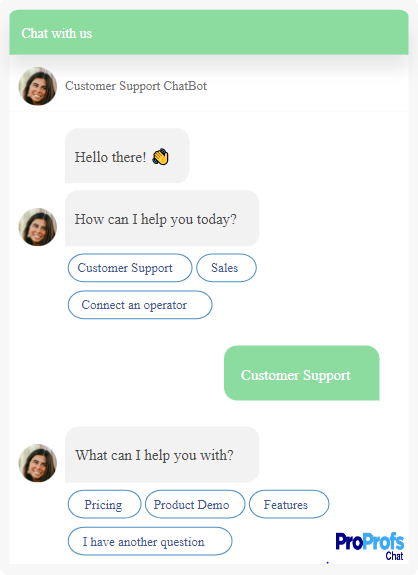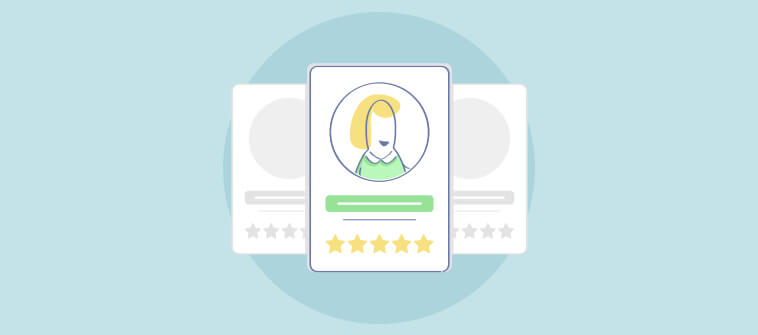Development, sales, design, and marketing teams need to put their best foot forward to keep your business moving forward. However, all their efforts can go down the drain if customers are unhappy with your service.
So here is the big question – how do you improve customer service desk process to create an army of delighted and loyal customers?
From encouraging self-service to automating repetitive tasks, there is a lot you can do today with technology that was not possible a few decades ago.
For instance, customer service desk software is a must-have business tool that can help your team collaborate effortlessly, offer proactive assistance, and monitor the quality of services delivered to customers across the globe.
This blog explores the various benefits of a customer service desk and highlights some impeccable strategies to improve its performance.
Here we go.
What Is a Customer Service Desk?
A customer service desk is a business software or tool that allows customer service teams to manage service requests and offer instant support from a single platform.
A service desk acts as a single point of contact (SPOC) between a business and its external customers and internal employees. With the help of this business tool, your business can create and implement robust workflows for your customer-facing support team. Your team will be aware of every step it needs to take to manage incidents, resolve customer issues, and ensure such problems can be prevented in the future.
Now, when we talk about IT services, most service desks are Information Technology Infrastructure Library (ITIL) compliant. ITIL lists best practices for businesses to manage the quality and delivery of their IT support services. However, there is also an evident shift.
Modern customer service desks are not limited to IT anymore. They are designed to manage both IT as well as non-IT services effectively.
A service desk improves customer experience by,
- Resolving issues and requests in the lowest turnaround time
- Making it easier for customers to approach a business
- Empowering customers to address common problems on their own
Why Do You Need a Customer Service Desk?
Whether you are a small startup or a well-established firm, a service desk can help you win your customers back. Let’s look at some of the top benefits of a customer service desk.
1. Improve Process Efficiency
Every business wants its departments to work in complete sync like a well-oiled machine. However, resolving customer problems is not the sole responsibility of the customer service department.
Every business department or team solves critical business problems. A service desk serves as a centralized location for all your customer communications and includes problems that can be solved with inputs from relevant departments. For instance, if a customer complains about repetitive software downtime, your IT team can step in and resolve the issue quickly.
2. Offer Proactive Customer Support
When most businesses think about customer service, they usually think of someone who contacted their support team for a problem and got the issue resolved. While this approach is the most common, reactive support might not lead to rigid solutions.
Instead of waiting for customers to bombard you with support tickets, a customer service desk helps you proactively support your customers. You can anticipate customer problems in advance and notify them before they start complaining. For instance, if a product delivery has been delayed due to bad weather conditions, the same can be informed to customers as soon as you get notified about it, instead of waiting for customers to complain.
Read More: Proactive VS Reactive Customer Service: Which One Should You Choose?
3. Measure Performance With Insightful Reports
Measuring performance helps your business track growth and monitor progress against intended goals. Keeping a bird-eye view of your customer service process helps you avoid customer churn due to poor service desk experiences.
With its insightful reports and analytics, a service desk can prove to be a game-changer for your business. You can track individual as well as team performance, measure performance against SLAs, and closely monitor customer-focused KPIs like CSAT, NPS, etc. Moreover, you can identify your top performers and offer them relative incentives to encourage their positive results.
4. Create a Vast Library of Information
Every business is generating an enormous amount of data that has the potential to reduce customer efforts, and save time, as well as costs. But are businesses able to tap into this valuable information?
With the help of customer service software tools, information pertaining to various customer problems can be stored in the knowledge database. Your staff can access them anytime and have all the knowledge they need about a problem right before their eyes. On the other hand, all this crucial information can be used to create self-help articles, FAQs, interactive videos, and more for customers to resolve their problems on their own.
How to Choose the Best Customer Service Desk Software
From pricing to scalability, a lot goes into buying a software product. In this section, we will discuss some tips that you can adopt to find the right customer service desk tool for your organization.
1. Jot Down the Features Your Team Can’t Go Without
The customer service desk features you get in a tool can make all the difference. It will be frustrating to use a tool that is focused on a single communication channel. That’s why investing in a system that offers diverse features is important.
Sit with your customer service team and jot down all the must-have features that you want in your tool. Then highlight the ones that you simply can’t do without, such as advanced reporting, ticket prioritization, canned responses, etc. The feature list will help you select the right tool that can meet your team’s unique requirements.
2. Prioritize Ease of Use
Many teams fear the struggle of shifting to a new tool as it can be time-consuming and drain your team’s productivity during the initial days. When choosing a customer service desk system, it’s important to consider how easy it’s going to be for your agents to get used to it.
You can opt for a product demo to ensure it’s not a complicated tool that only tech-savvy agents can handle. Go for an intuitive and simple interface that requires less training.
3. Select the Suitable Price
You don’t buy customer service desk software; you invest in it. It’s important to be mindful of the price and any other hidden charges that may be applicable.
If you opt for a cloud-based tool, you can enjoy flexible pay-per-user plans. So instead of paying a hefty one-time fee, you will be charged every month based on the plan you choose and the number of users.
4. Do Not Ignore Scalability
Over the course of time, businesses grow, and so does the number of customer service employees. If you think your business will expand in the near future, it’s important to choose a tool that offers high scalability.
A highly scalable solution will be able to meet your growing needs. Otherwise, your team will have to switch to another tool that can lead to further training, data transfer, and other complexities. Go for a tool that offers an Enterprise plan with advanced features and unlimited ticket creation capabilities.
Strategies to Improve Customer Service Desk Performance
Improving the performance of your customer support desk is not rocket science. With the right plan in place and some necessary tweaks to your process, you can witness some positive changes.
Here are 7 ways you can boost your service desk performance:
1. Focus on Improving Your First Contact Resolution (FCR)
FCR represents the number of customer issues solved by your support agents during their first interaction with your business.
A strong FCR is an indicator of exceptional service and shows that your customers are receiving all the right answers hassle-free.
Assign tickets to agents who have the right skill sets, training, and experience to handle them. Encourage them to act as a one-man army and escalate to second-level support only when required.
Ensure that critical customer information, such as past issues, contact history, etc., is available with your agents. This would prohibit the need to escalate or transfer a case due to the lack of sufficient information at hand.
Read More: 15 Help Desk Metrics to Improve Customer Support
2. Enhance Your Self-Service Capabilities
When a customer encounters an issue with a company’s products or services, where do they search for an answer? The internet.
Did you know that around 25% of customers search for relevant answers for 10-15 minutes online before approaching a business? This means that your self-service portal or knowledge base has more potential than you might think.
While creating your knowledge base, the last thing you would want to do is ‘assume.’ If the portal is meant for your customers, it’s best to ask them what works for them and what does not.
You can start by asking your customers questions like- Is the language easy to understand? Are they able to easily navigate through the portal? Are they able to find relevant content based on their search query?
Consistent testing of your self-service portal and imbibing valuable customer feedback should be the way forward.
3. Automate Repetitive Tasks
Support teams have a lot of tasks on their plates – handling angry customers, attending training sessions, taking follow-ups, and so on. Amidst this chaos, automation seems to be the only way out.
By automating mundane and repetitive tasks, you can reduce agent errors, speed up the issue resolution process, and reduce customer service costs.
Let’s see how this works.
You can make the most of the automation capabilities of customer service desk software. For instance, you can choose to automatically assign support tickets to available agents using the round-robin method. Similarly, you can share automated email notifications to inform agents and customers about ticket status. In addition, canned responses, also known as pre-designed email response templates, can also help you respond faster and enhance efficiency.
Read More: 10 Service Desk Automation Ideas that Boost Performance and Quality
4. Deploy Customer Service Chatbots
Another great way to automate your customer service is through chatbots. Unlike human agents, these bots can operate 24×7 and assist customers with their routine inquiries.
According to a study, 62% of customers prefer using a customer service chatbot rather than waiting for human reps to answer their requests.
Chatbots use artificial intelligence (AI) and pre-defined scripts to conduct human-like conversations with customers. For instance, bots can be developed to tackle basic questions such as, “What is your return policy?” or “Are there any ongoing offers?”
In addition, bots can utilize your company’s existing resources, such as knowledge base articles or FAQ pages, and share them with customers. This will also help you promote your knowledge base and reduce agent dependency.
Read More: Chatbot Pricing: Everything You Need to Know About Chatbot Cost
5. Encourage Team Collaboration
Providing your support agents with the best tools and training is one thing. Whereas building an inclusive and collaborative culture is another.
To improve customer service desk and deliver memorable experiences, you must look to encourage collaboration among team members. This will promote improved knowledge sharing among agents and lead to faster problem-solving.
Every service team receives critical issues that can jeopardize the business if not handled in time. And in such cases, you cannot expect a single agent to work on them.
For example, imagine multiple customers complaining that they are unable to add items to their online shopping cart. This will demand immediate collaboration between customer service and development teams.
6. Step Up Your Training Program
Even the most experienced employees require training when they become a part of your company. Consistent training can keep your team up and running and easily manage customer service challenges.
According to a LinkedIn study, 94 percent of employees would stay with a company longer if the company had made an investment in learning.
The true benefits of a service desk can’t be realized without a well-functioning team that receives ongoing training.
You need to understand that although modern customer service tools are easy-to-use, they are still known for regular updates. Every year, new problems arise from data breaches and new security protocols that need to be followed. SSL certificate is one of the security protocols that protect the data from data spying activities. A single SSL can encrypt the data that the customer service provider collects on the website. Therefore, keeping your team well-acquainted with all the latest updates and customer service trends is critical.
Just training your employees to use a business tool is not enough. You need to go beyond and train them on key customer service soft skills such as empathy, patience, persuasive skills, etc.
7. Learn From Valuable Feedback
You might have a great customer service strategy on paper, but what if customers feel you need to improve? Your service desk agents need to learn from customers’ feedback about the constraints to focus on.
“Feedback is the breakfast of champions”- Ken Blanchard
To improve your service desk performance, ask customers for their feedback by sharing a survey soon after their issue has been registered or resolved. You can also share surveys to gauge the potential of your self-service portal. While positive feedback can inspire your staff, negative feedback can shed light on improvement areas.
Capturing customer feedback is only the first step. You need to carefully analyze every piece of feedback and understand what is making customers unhappy even after a stringent process.
Instead of sweeping negative feedback under the rug, keep a close watch on trends that indicate common customer problems. Communicate with your customers that your business is working to ensure such issues can be avoided in the future.
Examples of Service Desk Software
Here are 5 examples of customer service desk software that you can choose for your business:
1. ProProfs Help Desk
ProProfs Help Desk is a complete service desk system that helps you stay on top of all requests and complaints. You can capture customer communications via email, live chat, help center, web forms, and multiple other channels.
With an intuitive live chat widget, you can proactively invite customers to chat and assist them in real-time. In addition, the tool allows you to build your own chatbots so that customers can receive basic assistance even when your chat operators are unavailable.
Top Features of ProProfs Help Desk:
- Manage SLAs with ticket overdue time
- Sort tickets based on their priorities (High, Low, or Normal)
- Add additional information about tickets using custom fields
- Reduce your ticket volume with a knowledge base
- Allow customers to track the progress of their help desk tickets
Pros:
- Automate customer service with chatbots
- Monitor CSAT, NPS, CES, and other metrics
Cons:
- Limited integration options
- Reporting can be more advanced
Pricing:
Starts at $20/agent/month (billed annually).
2. Freshdesk
The Freshdesk platform gives you an omnichannel view to manage customer requests and issues shared via email, chat, Facebook, and Twitter. Service agents can respond faster by using canned responses for commonly asked questions.
With Freshdesk’s internal knowledge management features, you can train new support agents and ensure relevant help is available 24×7. In addition, you can create a to-do list to set up reminders and follow-ups with customers.
Top Features of ProProfs Help Desk:
- Get a unified view of customer requests across channels
- Find hundreds of integrations in the Freshdesk marketplace
- Deflect routine queries with a knowledge base
- Enhance accountability by automatically assigning tickets to agents
- Monitor customer service metrics using a live dashboard
Pros:
- Mobile apps for Android and iOS
- Allow agents to update knowledge base articles
Cons:
- The Growth plan lacks essential features such as round-robin routing and custom roles
- Customizing reports can be confusing
Pricing:
Starts at $15/agent/month
3. Zendesk
Zendesk’s customer service suite is used by the biggest brands in the world to meet customer expectations. Whether customers drop a message or share their concerns via live chat, you can manage all conversations in one place.
Zendesk helps you reduce your ticket volume and free up agents so they can focus on urgent tasks. For instance, you can create an online help center and allow customers to resolve issues at their own pace.
Top Features of Zendesk:
- Allow customers to connect with each other on your community forum
- Empower agents to consistently update the knowledge base
- Automatically escalate issues to the best representatives
- Identify your best-performing knowledge base articles
- Monitor your CSAT score and other important metrics
Pros:
- Create AI-powered answer bots
- Reward community forum contributors with badges
Cons:
- Zendesk’s plans are quite expensive
- Reports are not always accurate
Pricing:
Starts at $49/agent/month
4. Help Scout
Help Scout is an easy-to-use customer service desk solution that comes with great ticket organization and automation features. The tool comes with the shared inbox feature to help you manage all your email inboxes from one place.
The tool allows you to capture customer satisfaction ratings and feedback so your team can improve support and enhance the customer experience. Moreover, real-time alerts let you know when someone else is viewing or replying to a ticket.
Top Features of Help Scout:
- Tag customer conversations to organize different types of requests
- Create a vast and searchable library of saved email replies
- Collaborate with teammates using private notes
- Access customer information and ticket history from the sidebar
- Easily find all the tickets you need with an advanced search function
Pros:
- Simple user interface
- Quickly toggle between email and chat conversations
Cons:
- Plans are expensive considering the features you get
- You will have to pay extra for additional mailboxes
Pricing:
Starts at $20/user/month
Read More: Best Help Scout Alternatives for 2023
5. Jira Service Management
Jira Service Management is a powerful ITSM tool that can help you enhance your internal support services. You can track all incidents and requests across your organization using this single platform.
You can empower IT end-users to find answers to routine questions using an online self-service portal. Your knowledge base can be used to present relevant help articles so IT users can get all the help they need without having to contact an agent.
Top Features of Jira Service Management:
- Create in-depth ticket forms that include only the relevant fields
- Capture requests from email, live chat, and other channels
- Create SLAs to avoid missing out on deadlines
- Escalate major incidents to speed up issue resolution
- Integrate Jira Service Management with Slack and Microsoft Teams
Pros:
- Leverage more than 300+ form templates
- Track the use of IT assets in one place
Cons:
- The tool comes with a steep learning curve
- Reporting can be overwhelming for new users
Pricing:
Starts at $20/agent/month
Make the Most of Your Customer Service Desk
It is no news that companies that focus on customer service outperform their rivals. Businesses that have mastered the art of delighting customers are available for their customers 24×7 and use sophisticated customer service tools.
A customer service desk can help your business resolve incidents, encourage team collaboration, and manage the complete lifecycle of your customer complaints. Through effective communication, a good service desk allows you to create a customer-centric culture where customer happiness is the top priority.
To improve customer service desk, focus on prioritizing metrics such as first contact resolution (FCR), encourage self-service, train your agents regularly, and implement valuable customer feedback or suggestions.
















